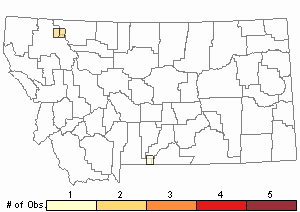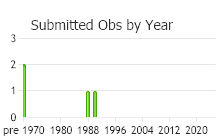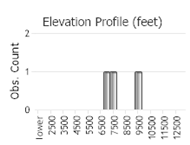View in other NatureServe Network Field Guides
NatureServe
Montana
Utah
Wyoming
Idaho
Wisconsin
British Columbia
South Carolina
Yukon
California
New York
A Windblown Moss - Paraleucobryum enerve
General Description
Plants: Acrocarpous (Vitt 1988), in closely-packed tufts, shiny, light green on top, brown below (Lawton 1971). Several rhizoids may be present at base (Flowers 1973). Stems 1-5(-10) cm (FNA 2007).
Leaves: The leaves are upright-spreading to slightly curved, narrowly lance-shaped and long-tapering to a finely acute point (forming a subula), 2-8 mm in length, 0.5-1 mm in width; margins smooth or, in upper leaf, with several small teeth facing the tip (FNA 2007). The margins are inrolled in the upper leaf to almost form a tube. The costa is smooth on the outer leaf surface (Flowers 1973), and 1-layered where it occupies about 9/10 of the leaf base, 3-6 cells across; it becomes broader and deeper at midleaf, covering the entire distal half of the leaf (FNA 2007).
Leaf Cells: Alar cells are 1-layered, brown, swollen, and reach the costa (FNA 2007); laminal cells are porose proximally and smooth; median laminal cells are nearly square to rectangular, elongated closer to the leaf base; the costa in X-section shows 3 cell layers consisting of 1 layer of green cells intermingled with colorless cells sandwiched between hyalocysts abaxially and adaxially; stereids not present (FNA 2007).
Phenology
Capsules ripen in summer (FNA 2007).
Diagnostic Characteristics
The specific name implies that the costa is absent. Although it outwardly looks like the leaves lack a costa (Flowers 1973), it actually covers the entire subula (FNA 2007).
Paraleucobryum longifolium, a species closely related to P. enerve, differs with its serrulate apex and the longitudinal ridges on the abaxial surface of its costa. P. enerve occasionally has a few serrulate teeth near the leaf apex, and the abaxial surface of its costa is smooth (FNA 2007).
Range Comments
North America: AK, YT and NT, extending s through BC and AB, MT, WY, and continuing s to AZ, NM, and Mexico; Greenland; Europe; Asia (FNA 2007). Known in Montana from Flathead, Glacier, and Stillwater Counties (Elliott 2016).
Observations in Montana Natural Heritage Program Database
Number of Observations: 5
(Click on the following maps and charts to see full sized version)
Map Help and Descriptions
Relative Density

Recency



 (Observations spanning multiple months or years are excluded from time charts)
(Observations spanning multiple months or years are excluded from time charts)
Habitat
Exposed noncalcareous cliffs, occasionally in fens and bogs (FNA 2007), soil and rock in alpine areas (Elliott 2016). Elevation: 500-14,100 feet (FNA 2007).
Reproductive Characteristics
Dioicous (Lawton 1971). Seta 10-20 mm in length, single or seldom 2 per perichaetium, smooth, upright, straight to twisted, ochre-colored. Capsules are straight or curved a little (Flowers 1973), cylindric, grooved when dry, ochre; the urn is 2-3 mm in length; the operculum is 1-1.5 mm in length (FNA 2007) and long-beaked (Lawton 1971).
Stewardship Responsibility
References
- Literature Cited AboveLegend:
 View Online Publication
View Online Publication Elliott, J.C. and A.K. Pipp. 2018. A Checklist of Montana Mosses (1880-2018). Updated 3 January, 2020. Montana Natural Heritage Program, Helena, Montana. 73 pp.
Elliott, J.C. and A.K. Pipp. 2018. A Checklist of Montana Mosses (1880-2018). Updated 3 January, 2020. Montana Natural Heritage Program, Helena, Montana. 73 pp. Flora of North America Editorial Committee, eds. 2007. Flora of North America North of Mexico. Volume 27. Bryophytes: Mosses, Part 1. Oxford University Press, Inc., NY. xxi + 713 pp.
Flora of North America Editorial Committee, eds. 2007. Flora of North America North of Mexico. Volume 27. Bryophytes: Mosses, Part 1. Oxford University Press, Inc., NY. xxi + 713 pp. Flowers, S. 1973. Mosses: Utah and the West. Brigham Young University, Provo, Utah. 567 p.
Flowers, S. 1973. Mosses: Utah and the West. Brigham Young University, Provo, Utah. 567 p. Lawton, E. 1971. Moss Flora of the Pacific Northwest. Hattori Botanical Laboratory. Japan: Yamabuki-cho, Shinjuku-ku, Tokyo. 362 pages plus appendices.
Lawton, E. 1971. Moss Flora of the Pacific Northwest. Hattori Botanical Laboratory. Japan: Yamabuki-cho, Shinjuku-ku, Tokyo. 362 pages plus appendices. Vitt, D.H., J.E. Marsh and R.B. Bovey. 1988. Mosses, Lichens and Ferns of Northwest North America. Lone Pine Publishing, Canada. 296 pp.
Vitt, D.H., J.E. Marsh and R.B. Bovey. 1988. Mosses, Lichens and Ferns of Northwest North America. Lone Pine Publishing, Canada. 296 pp.
- Additional ReferencesLegend:
 View Online Publication
View Online Publication
Do you know of a citation we're missing? Elliot, J. C. 1993. Second checklist of Montana mosses. Unpublished report. U.S. Forest Service, Region 1. Missoula, MT. 45 pp.
Elliot, J. C. 1993. Second checklist of Montana mosses. Unpublished report. U.S. Forest Service, Region 1. Missoula, MT. 45 pp. Lawton, E. 1971. Keys for the Identification of the Mosses on the Pacific Northwest. Reprinted from 'Moss Flora of the Pacific Northwest'. Published as Supplement No. 2 of the Journal of the Hattori Botanical Laboratory. Nichinan, Miyazaki, Japan. 66 pp.
Lawton, E. 1971. Keys for the Identification of the Mosses on the Pacific Northwest. Reprinted from 'Moss Flora of the Pacific Northwest'. Published as Supplement No. 2 of the Journal of the Hattori Botanical Laboratory. Nichinan, Miyazaki, Japan. 66 pp.
- Web Search Engines for Articles on "A Windblown Moss"





